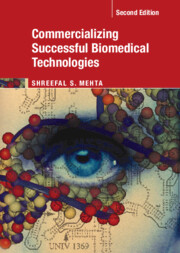Book contents
- Commercializing Successful Biomedical Technologies
- Commercializing Successful Biomedical Technologies
- Copyright page
- Dedication
- Contents
- Preface
- Acknowledgments
- 1 The biomedical device and drug industry and their markets
- 2 Markets of interest and market research steps
- 3 Starting up your company
- 4 Intellectual property and licensing
- 5 New product development (NPD)
- 6 The regulated market: gateway through the FDA
- 7 Manufacturing
- 8 Reimbursement, marketing, sales, and product liability
- Glossary
- Index
- References
5 - New product development (NPD)
Published online by Cambridge University Press: 03 November 2022
- Commercializing Successful Biomedical Technologies
- Commercializing Successful Biomedical Technologies
- Copyright page
- Dedication
- Contents
- Preface
- Acknowledgments
- 1 The biomedical device and drug industry and their markets
- 2 Markets of interest and market research steps
- 3 Starting up your company
- 4 Intellectual property and licensing
- 5 New product development (NPD)
- 6 The regulated market: gateway through the FDA
- 7 Manufacturing
- 8 Reimbursement, marketing, sales, and product liability
- Glossary
- Index
- References
Summary
New product development processes need to be compliant to regulatory requirements, and this chapter highlights the salient processes and quality systems to put into place to achieve success. Project management is made simple with specific tools provided here. Customer feedback is channeled into specific product characteristics, and the right tools are shown in this chapter. The biopharma industry has statistics showing less than 10% of starting compounds succeed in reaching market approval, and this chapter explains what causes these failures. The key issues that have repeatedly caused failure during device and diagnostic product development are also pointed out. Ethical decisions have to be made during product development as shown in this chapter. Outsourcing is a real option due to the availability of many contract research and manufacturing organizations, and judicious use of this option is discussed in this chapter. Key milestones that reduce risk and show transition from early stage to preclinical prototype stages are reviewed here. Does the popular concept of minimum viable product in software development apply in biomedicine prototyping? Other similar questions that help the reader understand pitfalls and best practices are answered here.
Keywords
- Type
- Chapter
- Information
- Commercializing Successful Biomedical Technologies , pp. 163 - 238Publisher: Cambridge University PressPrint publication year: 2022



